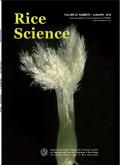与杜鹃花共栽水稻根系构型、发育时间、转录和激素谱的变化
IF 6.1
2区 农林科学
Q1 AGRONOMY
引用次数: 0
摘要
提高水稻产量的战略需要跟上预期的全球人口增长的步伐,并可持续地应对气候变化带来的挑战。在东南亚国家,水稻种植受益于使用杜鹃属植物提供氮。由于与固氮蓝藻毛藻共生,杜鹃花属蕨类植物在生物量分解时向环境中释放氮。然而,是否以及在多大程度上积极种植杜鹃花影响共栽培水稻幼苗的发育尚不清楚。为了解决这个问题,水稻(Oryza sativa L. var. Kitaake)幼苗与杜鹃(Azolla filiculoides)共水培两个月。水稻根系和空中器官的形态变化与水稻根系的一氧化氮测定、根系转录组学和水稻根系、叶片和生长介质的靶向激素组学一起进行了评估。本研究表明,与积极生长的黄花蒿共栽培通过诱导一氧化氮的增加改变了水稻根系结构,加速了叶片和分蘖的分化和增殖。综上所述,本研究深入分析了共栽培黄花菜对水稻营养生长早期形态发生的影响。这也为评估黄花楸共栽是否能使水稻更好地抵御非生物和生物胁迫的研究铺平了道路。本文章由计算机程序翻译,如有差异,请以英文原文为准。
Assessing Changes in Root Architecture, Developmental Timing, Transcriptional and Hormonal Profiles in Rice Co-Cultivated with Azolla filiculoides
Strategies for increasing rice yield are needed to keep pace with the expected global population growth and sustainably address the challenges posed by climate change. In Southeast Asian countries, rice farming benefits from the use of Azolla spp. for nitrogen supply. By virtue of their symbiosis with the nitrogen-fixing cyanobacterium Trichormus azollae, Azolla spp. are ferns that release nitrogen into the environment upon biomass decomposition. However, whether and to what extent actively growing Azolla plants influence the development of co-cultivated rice seedlings remains unclear. To address this, rice (Oryza sativa L. var. Kitaake) seedlings were co-cultivated hydroponically with Azolla filiculoides for up to two months. Morphological changes in rice roots and aerial organs were assessed alongside nitric oxide assays in rice roots, root transcriptomics, and targeted hormonomics of rice roots, leaves, and growth media. Here, we showed that co-cultivation with actively growing A. filiculoides alters rice root architecture by inducing a nitric oxide boost and accelerates leaf and tiller differentiation and proliferation. Overall, this study provides an in-depth analysis of the morphogenetic effects of co-cultivated A. filiculoides on rice during early vegetative growth. It also paves the way for studies assessing whether A. filiculoides co-cultivation primes rice plants to better withstand abiotic and biotic stresses.
求助全文
通过发布文献求助,成功后即可免费获取论文全文。
去求助
来源期刊

Rice Science
Agricultural and Biological Sciences-Agronomy and Crop Science
CiteScore
8.90
自引率
6.20%
发文量
55
审稿时长
40 weeks
期刊介绍:
Rice Science is an international research journal sponsored by China National Rice Research Institute. It publishes original research papers, review articles, as well as short communications on all aspects of rice sciences in English language. Some of the topics that may be included in each issue are: breeding and genetics, biotechnology, germplasm resources, crop management, pest management, physiology, soil and fertilizer management, ecology, cereal chemistry and post-harvest processing.
 求助内容:
求助内容: 应助结果提醒方式:
应助结果提醒方式:


